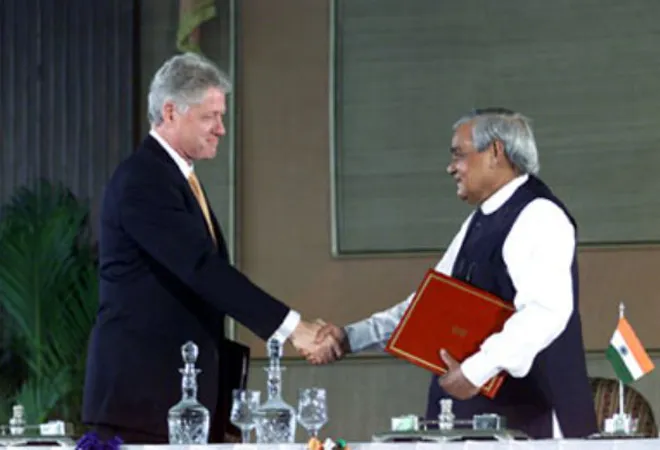
This piece is part of the series,
25 Years Since Pokhran: Reviewing India's Nuclear Odyssey
In May 1998, India conducted a series of nuclear tests at the Pokhran underground testing site. On 11 May 1998, three devices were
detonated simultaneously, including a fission device with a yield of approximately 12 kilotons, a thermonuclear device with a yield of about 43 kilotons, and a sub-kiloton device. Two additional tests took place on 13 May 1998. The tests proved to be fundamentally consequential for India’s regional as well as global relations but in two very different ways. Regionally, it signalled India’s arrival on the nuclear stage and repositioned India vis-à-vis threats within the region, most starkly Pakistan. Globally, India’s tests were not viewed as its strategic coming-of-age but as a transgression, potentially leading to proliferation concerns. Perhaps, most conspicuously, the international sanctions imposed in the aftermath of the tests, led by the United States (US) in this regard, came as a setback for India’s global relations, most importantly with the US itself.
Colossal intelligence failure
The inability of the US intelligence agency, most prominently, the Central Intelligence Agency (CIA), to pre-empt the nuclear tests by India proved to be a colossal
failure, as they were unable to detect any signs of India's preparations. Most disparagingly though, came US political debates on how India’s extensive efforts to hide the tests were attempts at ‘
denial and deception’, adding to international embarrassment for the US and casting doubts on its ability to credibly verify the Comprehensive Test Ban Treaty (CTBT) in the future. Politically, the tests were a major blow to the Clinton administration and its efforts to champion the nuclear non-proliferation regime.
The international sanctions imposed in the aftermath of the tests, led by the United States (US) in this regard, came as a setback for India’s global relations, most importantly with the US itself.
A couple of years earlier in 1996, President Clinton made history by being the first global leader to sign the Comprehensive Nuclear Test Ban Treaty (CTBT), which forbade nuclear weapon tests and/or explosions. However, his attempts to get the treaty ratified were declined in the Senate. The tests by India also nipped all expectations of India signing the nuclear Non-Proliferation Treaty (NPT) in the bud.
Faltering relationship
The growing momentum in India-US relations, due to the erstwhile Soviet Union’s collapse in the last decade of the 20
th century, was immediately impeded by a US-led sanctions regime against India for the 1998 nuclear tests. The US, along with several other countries, implemented
political, economic, and technological sanctions against India. According to the Glenn Amendment—a provision within the Arms Export Control Act of 1994—there was a legal obligation to enforce sanctions on both India and Pakistan following their nuclear tests conducted in May 1998. The table below details some of the sanctions required by the Glen Amendment to be imposed by a US President.
Table 1: Sanctions required by the Glen Amendment
| 1. Suspend foreign aid (except for humanitarian assistance or food and other agricultural commodities); |
| 2. Terminate sales of any military items; |
| 3. Terminate other military assistance; |
| 4. Stop credits or guarantees to the country by US government agencies; |
| 5. Vote against credits or assistance by international financial institutions; |
| 6. Prohibit US banks from making loans to the foreign government concerned; and |
| 7. Prohibit exports of specific goods and technology with civilian and military nuclear applications. |
Source: https://www.nonproliferation.org/wp-content/uploads/npr/morrow64.pdf
The
sanctions included terminating or suspending foreign assistance under the Foreign Assistance Act, although exceptions were made for humanitarian aid and food/agricultural commodities. Additionally, foreign military sales under the Arms Export Control Act were halted, and licenses for the commercial sale of items on the US munitions list were revoked. The US government entities, such as the Export-Import Bank of the US (EXIM) and the Overseas Private Investment Corporation (OPIC), ceased new commitments of credits and credit guarantees. To reinforce the impact of the Glenn Amendment, which required the US to oppose non-basic human needs loans for India and Pakistan from international financial institutions (IFIs), the US garnered G-8 support to postpone consideration of such loans. Furthermore, an executive order was issued to prohibit US banks from providing loans or credits to the governments of India and Pakistan. The export of all dual-use items controlled for nuclear or missile purposes was denied, and a presumption of denial was applied to other dual-use exports involving entities associated with nuclear or missile programs. These comprehensive measures reflected the extent of US sanctions on India in 1998 and their impact on multiple sectors of bilateral engagement. These sanctions were intended to isolate India and dissuade its pursuit of nuclear weapons. The measures imposed aimed to restrict trade, investment, and technology transfers to India, particularly in the field of nuclear technology.
The imposition of sanctions had an immediate impact on bilateral relations between India and the US, yet these sanctions were not lasting as they were
lifted within a few months of their imposition. In the short term, sanctions hindered cooperation in various fields, including trade, technology transfer, and scientific collaborations, but were designed in a
manner that minimised US interests and targeted government rather than people. The US Congress gave the president the power to lift all
remaining sanctions by 1999. The Pokhran-II tests forced the US to reassess its non-proliferation policy towards India. Recognising India as a de facto nuclear power, the US began to pursue a policy of engagement rather than isolation. This shift in approach paved the way for the subsequent improvement in bilateral relations.
To reinforce the impact of the Glenn Amendment, which required the US to oppose non-basic human needs loans for India and Pakistan from international financial institutions (IFIs), the US garnered G-8 support to postpone consideration of such loans.
The debate In the US with respect to sanctions on India was divided into two camps. The proponents of sanctions argued that Indi’'s nuclear tests violated the global non-proliferation regime and undermined efforts to prevent the spread of nuclear weapons. They believed that imposing sanctions on India was necessary to demonstrate the international communit’'s strong opposition to nuclear proliferation and to deter other countries from following a similar path. These proponents emphasised the importance of upholding the Nuclear Non-Proliferation Treaty (NPT) and preventing the erosion of its norms. Opponents of sanctions, on the other hand, focused on the broader geopolitical context and argued for a more pragmatic approach. They acknowledged that Indi’'s nuclear tests were a reality and believed that isolating India would be counterproductive. They argued that maintaining engagement with India was crucial to influence its behaviour positively, promote non-proliferation objectives, and enhance stability in South Asia. They also highlighted Indi’'s democratic system, its strategic location, and its potential as a market for American goods and services, suggesting that punitive measures could damage long-term US interests.
Over time, as India-US relations gradually improved and the strategic importance of engaging with India became evident, bilateral relations assumed an upward trajectory. The circumstances compelled internationally due to the 9/11 attacks in the US created grounds for convergence in the security domain. These sentiments were consolidated by the Bush administration’s
National Security Strategy in 2002 in its enunciation that the US has, “undertaken a transformation in its bilateral relationship with India based on a conviction that U.S. interests require a strong relationship with India.” Calling India, a potential great power, the Bush administration identified some critical pillars for basing strong US-India relations on democracy, increasing economic freedom, fighting terrorism, and creating a strategically stable Asia.
The signing of the US-India Civil Nuclear Agreement in 2005 was a significant milestone, as it marked an easing of nuclear proliferation concerns apropos India and a shift towards normalisation of relations and greater cooperation in the nuclear energy sector.
Nonetheless, differences between India and the US remained on various issues but particularly on India’s nuclear and missile programmes. The signing of the US-India Civil Nuclear Agreement in 2005 was a significant milestone, as it marked an easing of nuclear proliferation concerns apropos India and a shift towards normalisation of relations and greater cooperation in the nuclear energy sector. The
Safeguards Agreement was an important step in implementing the US-India Civil Nuclear Cooperation Initiative. The approval of India's safeguards agreement by the IAEA Board of Governors, on 1 August 2008, cleared the path for India's potential inclusion and assessment at the Nuclear Suppliers Group. Much of this recalibration was underscored by changing geostrategic compulsions in Asia with the rise of China and the need for a long-term continental strategy to balance Beijing.
The arc of US-India relations has come a long way from the days of sanctions to representing a ‘
global strategic partnership’. The growing convergences between India and the US in their strategic cooperation, externalities in the Indo-Pacific, and policy shifts on either side have paved the way for the reconfiguration of their relationship.
Vivek Mishra is a Fellow with the Strategic Studies Programme at ORF
The views expressed above belong to the author(s). ORF research and analyses now available on Telegram! Click here to access our curated content — blogs, longforms and interviews.



 This piece is part of the series,
This piece is part of the series,  PREV
PREV


